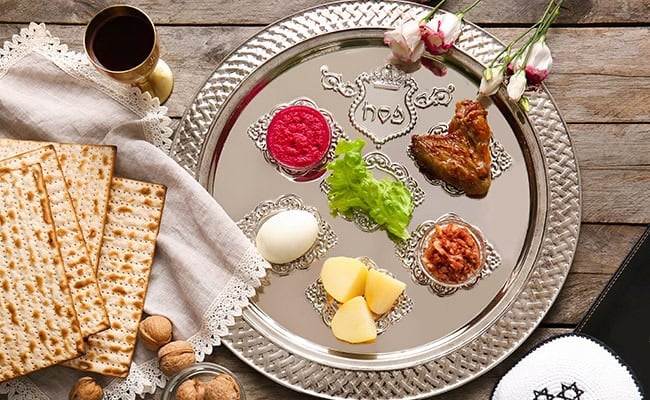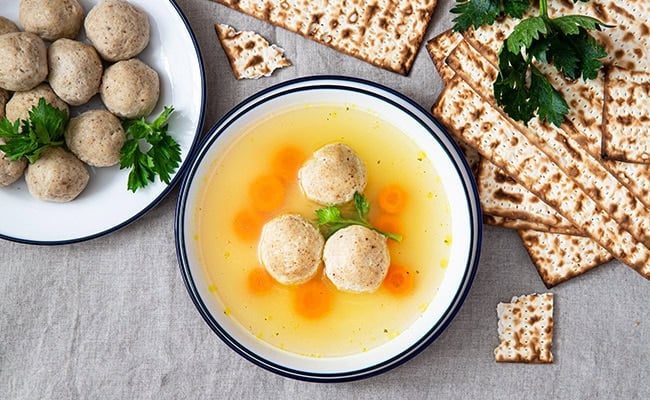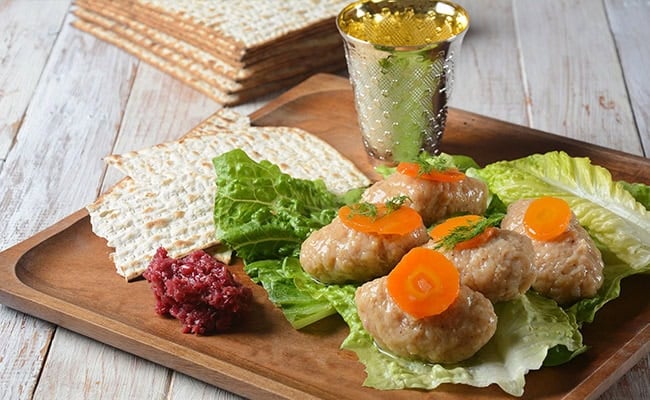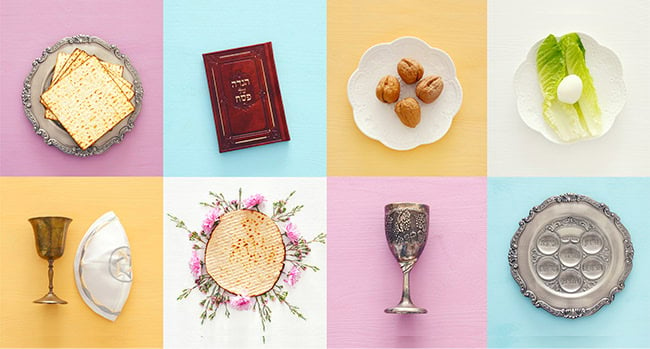Passover is one of the most revered Jewish holidays, marked by families gathering worldwide for Seder dinners and cherished traditions. This holiday serves as a poignant reflection on Jewish history, customs, and beliefs, centering on the timeless narrative of freedom from ancient Egyptian bondage. Make your Passover 2026 special (and wish your Jewish friends “Happy Passover”) with this resource—including recipes for Matzo ball soup and more! Please share your family heritage (and photos) with the Farmers’ Almanac community here in the comments below!
Jump to the Matzo Ball Soup Recipe
When Is Passover 2026?
Passover 2026 begins at sundown on Thursday, April 2, 2026, and ends the evening of Thursday, April 9, 2026. Passover 2027 is April 21-29; Passover 2028 is April 10-18, Passover 2029 is March 31-April 7.
Note: All Jewish people in Israel observe Pesach (Passover) for 7 days rather than the 8 days that are customary for those living outside of Israel. Learn more about this via ReformJudaism.org.
Why Are Passover Dates Different Each Year?
To understand why Passover dates change each year, we need to look at how the Hebrew and Gregorian calendars work. The Hebrew calendar is based on both the Moon and the Sun. It matches up with the Moon’s phases and the Sun’s position to stay in line with the changing seasons. Passover, which celebrates the start of spring, begins on the 15th day of Nisan (Abib), which is the first month of the Hebrew year.
On the other hand, the Gregorian calendar, which is what most of the world uses today, is based only on the Sun and the way the seasons change. It does not consider the Moon’s cycles. To keep the calendar year in line with Earth’s journey around the Sun, the Gregorian calendar adds an extra day every four years, known as a Leap Year. In a similar way, the Hebrew calendar occasionally adds a 13th month called Adar II, which has 29 days, roughly every 2-3 years. These special adjustments help to fix the 11-day difference between the Gregorian calendar’s 365-day solar year and the Hebrew calendar’s 354-day lunar year. This makes sure that holidays like Passover always happen at the right time of year.
What Is Passover?
Historically, the word Passover refers to the death angel passing over the Israelites during the final plague, death of the first-born sons in Egypt. Following instructions to paint lamb’s blood on the doorposts of their houses in Egypt, God spared the Israelites and delivered them. Passover (Pesach) commemorates the Israelites triumphant deliverance from Egyptian bondage.
Families and friends gather annually during the first month (Nisan) on the Hebrew calendar to recount the liberation and commemorate the meal eaten by the Israelites in Egypt on the original Passover. (Seder dinner explained below.)
As instructed in Exodus 12:18, Passover begins and ends at nightfall, “In the first month, on the fourteenth day of the month at even, ye shall eat unleavened bread, until the one and twentieth day of the month at even.” (Even refers to evening.) You can read the biblical account of the first Passover, in Exodus, chapter 12 in the Old Testament.
How to Wish Someone “Happy Passover”
The Hebrew greeting “Happy Passover” is Pesach Sameach (pronounced PEH-sakh sah-MAY-akh). Pesach means“Passover.” Sameach means “happy.” A simple greeting appropriate for any Jewish holiday is Chag Sameach (KHAG sah-MAY-akh). It means “happy holiday” or “happy festival.”
You don’t need to speak Hebrew or Yiddish to extend cordial Passover greetings. In English, you can wish someone a Happy Passover, Happy Holiday, a Joyous Passover, or a Blessed Passover!
What is a Seder Dinner?
The phrases “Seder dinner” and “Passover Seder” mean the same thing. They both talk about a special meal and ceremony that happen on the first two nights of Passover, an important time in the Jewish year. (Note: You may choose to have a seder on every night of Passover, but it is not customary. Also see “What To Do On Nights Without A Seder Dinner” below.)
“Seder” is a Hebrew word that means “order,” and the Passover Seder has a set way of doing things, including rituals, prayers, and special foods listed in the Haggadah, the guidebook for this event. At the Seder, people tell the story of how the Jews left Egypt, moving from being slaves to being free. Here’s a simple explanation of what usually happens at a Seder dinner:
Reading the Haggadah: This book has all the prayers, blessings, stories, and steps for the Seder. Everyone takes turns reading from it to remember the story of leaving Egypt and why it matters. Download a free copy of the Haggadah, including a 34-page guide to conducting a Passover seder.
Special Foods: The Seder dinner plate has different foods that stand for parts of the story of leaving Egypt and the history of the Jewish people. These foods are eaten at certain times during the Seder while thinking about what they mean. (See details below.)
Four Cups of Wine: During the Seder dinner, everyone drinks four cups of wine (or grape juice), each one connected to a different part of the story of leaving Egypt and becoming free.
Eating Matzah: Matzah, or flat bread that didn’t rise, is important at the Seder dinner. It shows how quickly the Jews had to leave Egypt and reminds us to be humble.
Talking and Thinking: The Seder dinner is a time for everyone to talk, ask questions, and think about the story, especially kids. They get involved by asking questions and other parts of the ceremony that make it interactive.
A Seder dinner is also a great opportunity to discuss how themes of freedom, liberation, and redemption resonate with contemporary issues and challenges. This could include reflections on the universal significance of Passover’s messages of justice, equality, and human dignity.
Beyond the symbolic elements of the Seder plate and the recitation of the Haggadah, families often incorporate their own traditions and customs into the Seder dinner, fostering a sense of continuity and connection with their heritage.

Symbolic Seder Dinner Foods
Small portions of symbolic foods are arranged on a Seder dinner plate and prominently displayed on the table. These foods are tasted as the Israelites’ miraculous exodus story is retold.
Bitter herb (Maror): Horseradish or endive represents the years of bitter slavery that the Hebrews endured.
Chopped fruit, nuts, and wine (Charoset, Haroset or Charoses): This is a sweet spread or paste or spread made of fruits, typically apples, and nuts and wine. It symbolizes the mortar that the enslaved Israelites used to make bricks while building the Egyptian pharaohs’ cities. It also reminds us of the sweetness of freedom.
Mild green vegetable (Karpas): Celery, parsley, or lettuce is typically used on the Seder plate. At the onset of the ceremony, the karpas is dipped into salt water and eaten. The green vegetable symbolizes the new growth in spring, and the salt water represents the tears shed by the Israelites during their lengthy enslavement.
Roasted shank bone (Zeroah): Traditionally a lamb, but chicken is used now as well. It is symbolic of the lamb roasted on the night of the Israelites exodus and the sacrificial paschal lamb offered at the Temple in Jerusalem.
Roasted egg (Baytzah or Beitzah): A roasted egg is a symbol of an additional festival offering brought to the Temple on Pesach (Passover). The egg also represents mourning the Jews feel for the loss of the Temple.
Other Customary Practices
In addition to the Seder plate and the Haggadah, there are several other customary practices observed during Passover:
Removing Chametz: Before Passover begins, Jewish households engage in a thorough cleaning to remove all traces of chametz from their homes, symbolizing the removal of impurity and the start of a new, spiritually cleansed year. Chametz refers to any food product made from wheat, barley, rye, oats, or spelt that has come into contact with water and been allowed to ferment and rise.
Eating Matzah: Throughout the Passover holiday, participants abstain from consuming leavened bread and instead eat matzah, unleavened bread that represents the haste with which the Israelites left Egypt, not allowing time for their bread to rise.
Avoiding Fermented Foods: In addition to chametz, fermented foods and beverages, such as beer, are avoided during Passover to adhere to the prohibition against leavening agents.
Using Special Passover Utensils: Some observant Jews use separate sets of dishes, utensils, and cookware specifically designated for Passover use to avoid any contamination from chametz.
Kosher for Passover: Kosher means “fit.” Kosher food is “fit to eat” once it passes certain technical and dietary regulations that avoid prohibited foods. It is often certified kosher by rabbinical authorities. When shopping, look for food products with the “Kosher for Passover” certification. Food that’s okay to eat during Passover can’t have any of chametz and must not be made with machines that have touched them.
Overall, the rituals and practices observed during Passover serve to deepen participants’ connection to the Exodus narrative, reinforce core Jewish values, and foster a sense of communal identity and solidarity across generations.
Foods You Won’t Find at a Passover Seder
Many delectable foods are served during Passover, yet there are foods you won’t find on a traditional Seder table. Customary restricted foods may vary around the world. In a nutshell, the widely followed Passover dietary restrictions prohibit the consumption of these foods:
- Leavening agents (baking powder, baking soda, and yeast) The bread served at Passover represents the hasty departure and deliverance of the enslaved Jews from ancient Egypt. They were instructed not to wait for the bread to rise before fleeing. As this triumphant historical moment is remembered, no leavening agents are used.
- Ordinary Grains (wheat, oats, barley, rye, and spelt) Breads or other food products made from these grains that are mixed with water and allowed to ferment and rise are prohibited during Passover. Only Kosher matzo, unleavened flatbread made of flour and water is served at Passover. It is a reminder of how quickly the Israelites left Egypt as God instructed.
- Legumes (peas, beans, lentils, rice, soy) Food products containing any of these legumes are prohibited.
Recipes for Passover
We’ve put together a selection of recipes for you to experience the special foods of Passover. These delicious foods may be typically found at a Passover Seder or any meal during the Passover holiday. But you don’t have to attend a Passover meal to try any of these tasty, Jewish favorites.
Date and Pecan Haroset Recipe
(No cooking, food-processor recipe)
Yield: 1½ cups
Ingredients:
- 1 cup pitted dates
- 1 apple, peeled and diced
- ¾ cup pecan pieces (or walnuts, if preferred)
- 1 teaspoon cinnamon powder
- 1 teaspoon freshly grated ginger
- 2 tablespoons raw honey
- 3 tablespoons dessert red wine
Instructions:
- Chop dates in the food processor. Add the diced apple and nuts to the food processor and pulse to chop the nuts and thoroughly combine. Add the cinnamon, ginger, and honey, and pulse. Remove the top of the food processor and run a spatula around the sides of the container to thoroughly incorporate the mixture.
- Pour in one tablespoon of the sweet red wine and pulse. Add a second tablespoon and pulse again. Add the last tablespoon of wine, and pulse to incorporate.
- Transfer mixture to a glass storage container with lid and chill in the refrigerator until ready to serve. This can be made a day or two ahead.

Matzo Ball Soup Recipe
“Delicious homemade chicken soup with matzo balls.” Recipe via Tori Avey.
Yield: 16, 1½ cup servings.
Chicken Soup Ingredients:
- 4 pounds whole chicken
- 2 pounds celery stalks, cut into chunks
- 1-pound carrots, peeled and cut into chunks
- 1 yellow onion, skin on, rinsed, halved
- 2 ounces fresh parsley (one large handful), rinsed
- 1.5 ounces fresh dill (one handful), rinsed
- 2 teaspoons black peppercorns
- 3 whole cloves (optional- do not add unless you like the flavor of cloves)
- 2 bay leaves
- 1 tablespoon sea salt or more to taste
Instructions:
- Place whole chicken (without gizzards) in a 10 to 12-quart stock pot. Cover with 5 quarts of water.
- Bring water to a boil over medium heat, then reduce to simmer for 10-15 minutes. Skim off foam and particles that rise to the surface of the water periodically, until most of the foam is gone.
- Replenish the liquid that was removed during skimming with hot water, about 1 to 2 cups.
- Add the first pound of celery, onion, parsley (unchopped), 2/3 of the dill (unchopped), peppercorns, cloves, and bay leaves to the pot. Add 1 tablespoon of sea salt to the water. Bring back to a simmer. From this point on, it’s important not to let the soup come to a rolling boil. A slow and even simmer is best – if the soup boils quickly, the broth may become cloudy.
- Put the lid on the pot and vent it. Reduce heat to medium low so the soup is slowly simmering. Let the soup cook for roughly 90 minutes.
- Test for doneness by pulling the leg from the chicken. It should easily separate, showing that the chicken has become quite tender. When the chicken is ready, turn off the heat. Use a pair of tongs to carefully pull the chicken from the broth (it may fall apart into pieces as you pull it out – that’s a good sign!). Put it on a plate or in a bowl.
- Allow the chicken and the broth to cool down for 20-30 minutes. Carefully strain the broth into another pot or large bowl (6 quart) through a mesh strainer. Discard the celery and onion halves, spices, and herbs (which will be mushy and flavorless at this point).
- Pull the meat from the chicken bones and cut into bite-sized pieces.
- Add the reserved fresh cut veggies to the pot (1-pound celery and 1-pound carrots). Bring the broth to a simmer – not a boil – and let the vegetables cook for 20-30 minutes until tender.
- Remove stems from the remaining fresh dill and chop it up.
- Stir the cooked chicken pieces and the dill into the soup with the vegetables, and simmer for a couple of minutes more. Taste the chicken broth and season with additional sea salt, if desired.
Floater Matzo Soup Balls:
“The lightest, fluffiest floater matzo balls ever!” Recipe via Tori Avey.
Yield: 24 Servings.
Ingredients:
- 1 cup matzo meal
- 1/4 teaspoon sea salt, heaping
- 1/4 teaspoon garlic powder, heaping
- 1/4 teaspoon onion powder, heaping
- 1/4 teaspoon white pepper (optional)
- 4 large eggs
- 1/4 cup avocado oil, or safflower oil
- 1/4 cup unflavored seltzer
- 1 tablespoon minced fresh dill or parsley (optional)
- 5 quarts chicken stock
Instructions:
- Separate the egg whites from the yolks, putting the whites in a medium mixing bowl and the yolks in a small mixing bowl. Use a fork to stir together the egg yolks and oil, stirring briskly to make sure they are well blended. Gently stir in 1/4 cup of bubbly unflavored seltzer.
- In a second medium mixing bowl, use a fork to mix the matzo meal, salt, garlic powder, onion powder, and white pepper.
- Pour egg yolk mixture into the dry ingredients and add the minced dill or parsley. Mix with a fork until just combined. Do not over mix.
- Whip the egg whites with an electric mixer to form stiff peaks.
- Fold the whipped egg whites into the batter. Do not over-mix; you want the egg whites well integrated, but over-mixing will deflate them. Put the bowl of matzo ball mixture into the refrigerator and let it rest for 30 minutes.
- Bring your 5 quarts of chicken stock to a boil over medium heat.
- While your broth is warming, form the chilled matzo ball mixture into 1-inch balls (roughly walnut-sized). Don’t overwork the mixture when you roll the balls.
- When your broth boils, reduce heat to a simmer and drop the matzo balls gently into the liquid.
- Cover the pot with a lid and let the balls cook for 30-50 minutes until fluffy and soft. Keep the pot covered. No peeking for at least 30 minutes. The balls should be floating on the surface. If they seem dense, they need to cook longer. (Note. When you first open the lid, the matzo balls may sink to the bottom of the pot. That doesn’t mean you’ve failed to make floaters – it just happens when the lid comes off.)
- Test for doneness by slicing a matzo ball in half. It should look the same all the way through the center – tender, with no dark spot in the middle. If the middle is darker than the edges, it needs to simmer a little longer. It won’t be light and fluffy unless it is fully saturated with broth and cooked all the way to the center.
- Serve two or three matzo balls per bowl with hot chicken soup ladled over them. If you don’t plan on serving the whole pot of soup at one sitting, make sure you remove the matzo balls from the broth and let them come to room temperature before storing in a separate sealed container in the refrigerator. (Note. If left to sit in the broth, they’ll become mushy.)

Easy, Homemade Gefilte Fish Recipe
Poached and deboned ground fish balls/patties. Recipe by Moran Pinto.
Fish Ingredients:
- 1 carrot
- 1 onion
- 1 lb. ground carp (to grind fish, pulse without bones in a food processor)
- 2 tbsp. sugar
- 1 tbsp. ground black pepper
- 1 tbsp. kosher salt
- 1 cup matzo meal (approximately)
- 2 eggs
Broth Ingredients:
- 3 quarts (12 cups) water
- 4 bay leaves
- 5 whole peppercorns
- ½ cup sugar
- 1 tbsp. cracked black pepper
- 1 onion
Instructions:
Place the carrot and onion into a food processor and grind finely. Mix the carrot and onion mixture into the ground carp. Add in the salt, sugar, pepper, eggs, and matzah meal. Mix and form into balls. Place all the broth ingredients into a pot and bring to a boil. Drop in the fish balls and cook for 1 hour. Remove and refrigerate until serving. Serve with beet horseradish, if desired.
Notes: Carp is the traditional fish used in gefilte, but you can also use boneless cod, halibut, pike or white fish. Gefilte fish means (stuffed fish in Yiddish).
Miracle Bars
“Easy and yummy!” Recipe contributed by Dr. Eric Mintz of West Bloomfield, Michigan.
Ingredients:
- 2 large eggs, slightly beaten
- 2 cups ground almonds or almond meal
- 1 cup brown sugar
- 1 cup chocolate chips
Instructions:
- Preheat oven to 375°F.
- Grease a 9” x 13” pan with Kosher vegetable oil or coconut oil.
- Mix all ingredients in a bowl and mix thoroughly. Batter will be thick but do not add any water.
- Transfer batter into prepared pan and smooth with a spatula.
- Bake for 23 minutes.
- Cool in pan and cut into squares.
Chocolate Matzo
“This recipe was given to me by a friend several years ago. It was such a hit, I make it every year!” -Dr. Eric Mintz of West Bloomfield, Michigan.
Ingredients:
- 24 ounces (2 packages) semi-sweet chocolate chips
- ¼ cup Kosher vegetable oil
- 8 ounces matzah farfel (Jewish cuisine, sold in packages, it’s matzo broken into small pieces)
- 1 cup walnut pieces
- 1 cup raisins
- 10.5 ounces mini marshmallows (labeled Kosher for Passover)
Instructions:
- Carefully microwave chocolate and oil in a large glass bowl for one minute and stir. Repeat the process until chocolate is almost melted.
- Add the remaining ingredients into the bowl and mix all together with a large spoon.
- Line a tray with wax paper.
- Spread the mixture onto wax paper and place in the freezer overnight.
- The next day, break the candy into pieces.
- Place in sealable containers and keep refrigerated, or freeze.
More Classic Jewish Cuisine to Enjoy
Want to try more Jewish culinary favorites? Got a Jewish deli nearby? Offering a variety of choices, most Jewish delicatessens serve these flavorful meats: pastrami, brisket, and corned beef.
Latkes (fried potato pancakes) are a classic, served with sour cream or apple sauce.
Knishes (baked or fried pockets) filled with meats and/or vegetables such as caramelized onions, mashed potatoes, and cheese are a savory combination.
Doughless potato knishes are perfect for Passover.
Don’t forget dessert! Macaroons are a traditional treat.
What To Do On Nights Without A Seder Dinner
During Passover, when Jewish people are not having the special Seder dinner, they still follow the holiday’s traditions and rules about food. Here are some things they might do:
Eating Special Food: For the whole eight days of Passover, Jews don’t eat bread that has risen. This rule is for every meal, not just the Seders.
Going to Religious Services: People might go to special services at their place of worship or join in community events for Passover.
Studying Religious Texts: Passover is a good time to read and learn more about Jewish teachings, especially those about the Jews leaving Egypt and the ideas of freedom.
Thinking About the Exodus Story: Even when it’s not a Seder night, people think about the story of how the Jews left Egypt and what it means for life today. They might talk about it with family, go to talks, or join study groups.
Eating Together: Families still get together for regular meals during Passover, following the special food rules. These meals help family members feel close and keep up the holiday’s traditions.
Doing Good Things for Others: Passover talks a lot about freedom and fairness, so people might do things to help others or make the world a better place during this time.
So, even on non-Seder nights, Passover is a time for Jewish people to think, celebrate, and do things that are part of the holiday.
Join The Discussion
Are you planning a Seder dinner for Passover 2024?
What are some of your family’s traditions?
Share your thoughts with your community here in the comments below!
Related
Traditional Jewish Apple Cake Recipe






